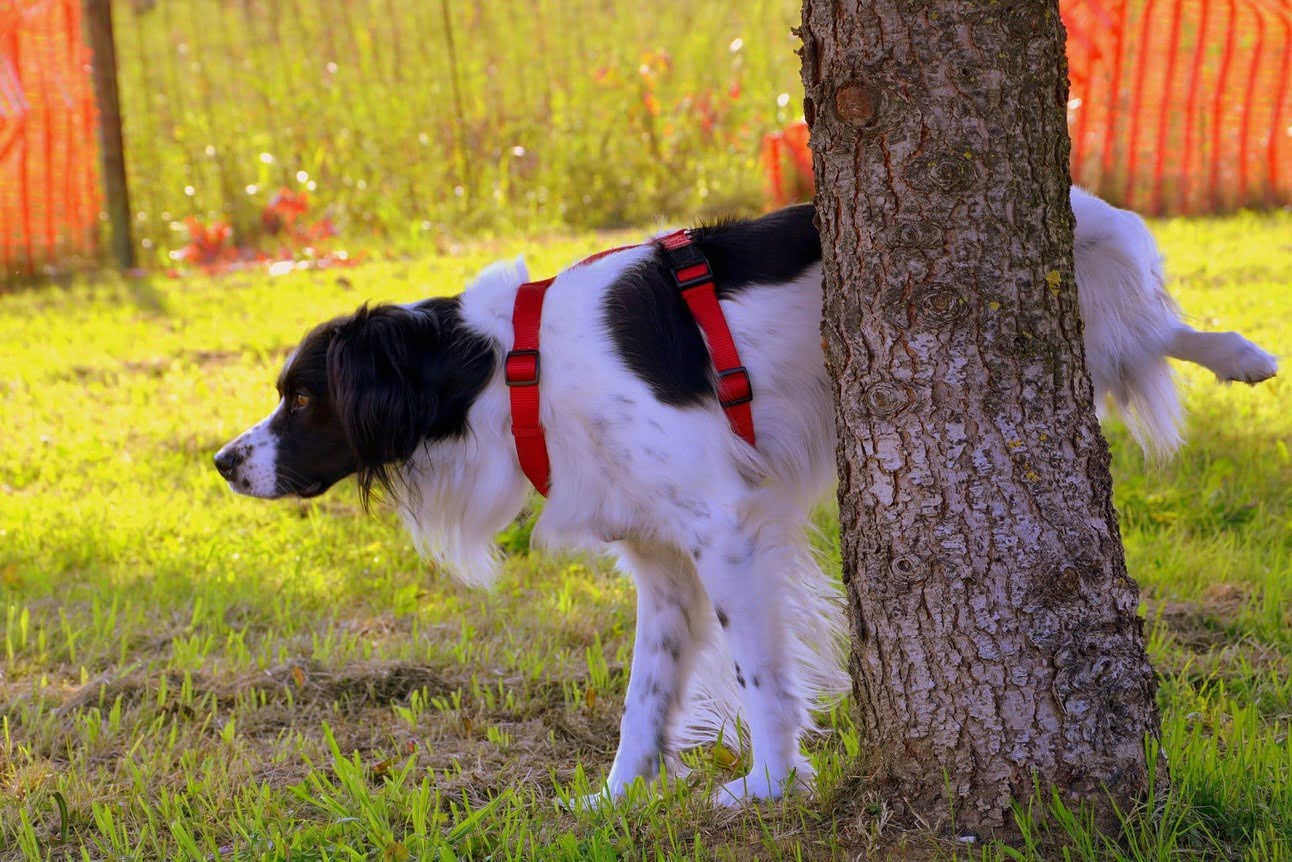Home>Gardening News and Trends>Latest News>Why Do Dogs Pee On Trees


Latest News
Why Do Dogs Pee On Trees
Published: October 23, 2023
Stay updated with the latest news on why dogs pee on trees. Discover the fascinating reasons behind this common behavior and learn how to better understand your furry friend.
(Many of the links in this article redirect to a specific reviewed product. Your purchase of these products through affiliate links helps to generate commission for Chicagolandgardening.com, at no extra cost. Learn more)
Table of Contents
Introduction
Dogs are fascinating creatures with their own unique behaviors and instincts. One behavior that often leaves us baffled is their tendency to urinate on trees. You may have witnessed this behavior while out on a walk with your furry friend or even in your own backyard. But why do dogs pee on trees? What is the significance behind this seemingly peculiar behavior?
While it may seem like a simple act of relieving themselves, there is actually a lot more to it than meets the eye. For dogs, marking territory through urination is an instinctual behavior that serves multiple purposes.
In this article, we will delve deeper into the fascinating world of canine marking behavior and explore the reasons behind why dogs pee on trees. We will uncover the natural instincts and communication methods that drive this behavior, as well as the social significance it holds among dogs.
Understanding why dogs engage in this behavior is not only interesting but also crucial for their well-being. By gaining insight into their actions, we can better comprehend their needs and provide them with a supportive and enriching environment.
So grab a cup of coffee, get comfortable, and let’s dive into the intriguing world of why dogs pee on trees!
The Importance of Marking Territory
Marking territory is a fundamental aspect of a dog’s behavior. By urinating on trees, dogs are able to establish a sense of ownership and convey important information to other members of their species. This behavior not only serves as a form of communication but also plays a significant role in maintaining social dynamics among dogs.
Marking territory through urine allows dogs to leave behind a scent that contains valuable information about themselves, such as their gender, reproductive status, and even their overall health. This scent acts as a calling card, alerting other dogs to their presence and providing important social cues.
From a dog’s perspective, marking territory is akin to leaving a personalized message for other dogs in the area. It lets them know who has been there, when they were there, and whether they are a friend or a potential rival. This helps establish boundaries and avoid unnecessary conflicts, as dogs can gauge whether they are intruding on another dog’s territory or vice versa.
Marking territory also serves as a means of asserting dominance and establishing a social hierarchy. Dogs, particularly male ones, may engage in marking behavior more frequently in the presence of other dogs to assert their dominance and assert their status within the pack.
It is important to note that dogs have a highly developed sense of smell, far superior to that of humans. While we may not be able to detect the scent left behind by a dog’s urine, other dogs can pick up on these signals from quite a distance. This reinforces the importance of marking territory as a means of communication among dogs.
So the next time you see your furry friend peeing on a tree, remember that they are not just relieving themselves but engaging in a complex and vital behavior. By marking their territory, dogs are asserting their presence, exchanging information, and maintaining the intricate social dynamics that govern their interactions.
Natural Instincts and Communication
Marking territory through urination is deeply ingrained in a dog’s natural instincts and serves as a vital form of communication. Dogs have a highly developed sense of smell, allowing them to gather a wealth of information from just a whiff of another dog’s urine.
When dogs urinate on trees or other objects, they leave behind a distinct scent that contains chemical signals known as pheromones. These pheromones carry a wealth of information, including the dog’s gender, age, health status, and even their reproductive availability. It’s like a canine “business card” containing all the vital details!
Other dogs will sniff these pheromones and interpret the messages encoded within them. This communication allows dogs to gather information about the presence of other dogs in the area, establish social hierarchies, and even initiate or avoid potential conflicts.
Additionally, marking territory is a way for dogs to assert their individuality and personal identity within a larger community. Each dog’s urine has a unique scent profile, similar to a fingerprint, allowing other dogs to differentiate between individuals. This helps with recognizing familiar dogs, maintaining social bonds, and establishing boundaries.
Dogs also engage in what is known as “overmarking” or “counter-marking,” where they intentionally urinate over the urine of another dog. This behavior is a direct response to the pheromones left behind by the previous dog, indicating a form of social interaction and a desire to leave one’s own scent in proximity to another dog’s marking.
It’s important to understand that this marking behavior is not limited to just trees. Dogs may also mark other objects such as fire hydrants, lampposts, or even the corners of buildings. The choice of object is often influenced by factors such as height, location, and other dogs’ previous marking behaviors in the area.
So, the next time you see your dog pee on a tree, remember that they are engaging in a complex form of communication, using their powerful sense of smell to exchange vital information with fellow canines in their community.
Scent and Social Significance
The scent left behind by a dog’s urine plays a crucial role in their social interactions and holds significant social significance among canines. Dogs have a highly developed sense of smell, allowing them to gather a wealth of information from the scent left behind by their fellow furry friends.
When a dog pees on a tree or any other object, they are not only leaving behind their own scent but also picking up on the scents left by other dogs before them. This creates a complex olfactory landscape that acts as a social record of the dogs that have passed through the area.
The ability to read and interpret these scents allows dogs to gather information about the presence of other dogs, including their gender, reproductive status, and even emotional state. This helps them understand the social dynamics of their community and make informed decisions about how to interact with other dogs.
The scent left by a dog’s urine also serves as a form of non-verbal communication, allowing dogs to convey messages to each other. For example, a dog may mark a tree with their urine to indicate their presence in a particular area and establish their territorial boundaries. This helps prevent unnecessary conflicts by signaling to other dogs that they are encroaching on another dog’s territory.
Additionally, the scent left by a dog’s urine can evoke specific responses and behaviors in other dogs. It can trigger curiosity, territorial responses, or even changes in mood. This interplay between scent and behavior is an integral part of canine socialization.
In multi-dog households, where multiple dogs share the same living space, marking behavior can play a crucial role in establishing a hierarchy and maintaining social order. Dogs may engage in marking objects in the home to assert their dominance or reaffirm their position in the pack.
It’s important to note that scent marking is not limited to social interactions among dogs. It can also serve as a way for dogs to communicate with humans. For example, a dog may urinate in an inappropriate location to mark their territory within the household or to seek attention from their human companions.
Understanding the significance of scent in canine communication helps us appreciate the complex world of dogs and their social interactions. So next time you see your dog sniffing and marking their territory, remember that they are engaging in a sophisticated form of communication, using their incredible sense of smell to navigate their social world.
Marking Behavior in Male Dogs
Marking behavior in male dogs is often more pronounced compared to females. This is primarily because male dogs have higher levels of hormones, specifically testosterone, which drives their urge to mark their territory.
Male dogs use urine marking as a way to assert their dominance and advertise their presence to other dogs. They will often lift their hind leg and spray small amounts of urine on vertical surfaces such as trees, lampposts, or even furniture.
Marking behavior in male dogs is not limited to outdoor environments. They may also mark objects inside the house, especially if there are other dogs or unfamiliar scents present. This behavior helps establish dominance and create clear boundaries within their territory.
Male dogs are more likely to engage in overmarking, where they will urinate over the scent marks left by other dogs. This is a way for them to assert their dominance and establish their presence, especially in areas with high dog traffic or competition.
It’s important to note that marking behavior in male dogs can become excessive or problematic, particularly if they are not neutered. Neutering can help reduce the levels of testosterone in male dogs and minimize the tendency to engage in excessive marking.
If your male dog is exhibiting excessive marking behavior, it’s important to consult with a veterinarian or a professional dog trainer. They can provide guidance on training techniques and strategies to manage the behavior effectively.
By understanding the motivations behind marking behavior in male dogs, we can better support their needs and create an environment that promotes positive social interactions and reduces unnecessary territorial conflicts.
Marking Behavior in Female Dogs
While marking behavior is often associated more with male dogs, female dogs also engage in marking, although to a lesser extent. The primary driving force behind marking behavior in female dogs is not dominance or territoriality like in males, but rather communication and reproductive signaling.
Female dogs may mark their territory with urine to communicate their reproductive status to potential mates. When a female is in heat, her urine contains chemical signals that indicate her fertility. By marking their territory, female dogs can attract the attention of male dogs and signal their availability for mating.
Female dogs may also engage in marking behavior in response to the presence of other dogs, both male and female. This can be a way for them to assert their presence and communicate their social boundaries. However, this behavior is generally less frequent and less pronounced compared to male dogs.
Marking behavior in female dogs is not limited to outdoor environments. They may also mark objects inside the house, particularly if there are other dogs or unfamiliar scents present. This behavior helps establish familiarity and boundaries within their shared living space.
It’s important to note that marking behavior in female dogs can become more apparent during their heat cycle. During this time, they may exhibit a heightened urge to mark and may be more prone to overmarking the scent marks of other dogs.
If your female dog’s marking behavior becomes excessive or problematic, it is recommended to consult with a veterinarian or a professional dog trainer. They can provide guidance and strategies to manage the behavior effectively, especially during the heat cycle.
Understanding the motivations behind marking behavior in female dogs helps us better understand their unique communication needs. By providing a supportive environment and training, we can ensure that their marking behavior is appropriately channeled and does not lead to issues within the household or with other dogs.
Medical Reasons for Frequent Urination
While marking behavior is a natural instinct for dogs, it’s important to differentiate between normal marking and frequent urination that may be caused by medical conditions. If your dog is exhibiting excessive urination or has suddenly increased their frequency of marking, it may be a sign of an underlying health issue.
One common medical cause for frequent urination in dogs is a urinary tract infection (UTI). UTIs can cause discomfort and inflammation in the urinary tract, leading to an increase in urinary frequency as the dog attempts to flush out the infection.
Bladder stones or crystals in the urine can also lead to increased urination. These stones can irritate the bladder lining and result in a frequent urge to urinate. Similarly, bladder infections or cystitis can cause similar symptoms.
Endocrine disorders such as diabetes or Cushing’s disease can affect a dog’s ability to regulate their water intake and urine output. Dogs with diabetes may exhibit signs of increased thirst and urination, as their bodies struggle to process glucose properly. Cushing’s disease can cause an increase in cortisol levels, leading to increased water intake and subsequent frequent urination.
In some cases, hormonal imbalances such as an overactive thyroid gland (hyperthyroidism) or an underactive adrenal gland (hypoadrenocorticism or Addison’s disease) can cause changes in a dog’s urinary habits.
If you notice your dog urinating more frequently than usual or exhibiting other symptoms such as excessive thirst, loss of appetite, lethargy, or blood in the urine, it is crucial to consult with a veterinarian. They can perform a thorough examination, run diagnostic tests, and determine the underlying cause of the increased urination.
Treatment for frequent urination will depend on the underlying cause. It may include medications to address infection or hormonal imbalances, dietary changes to dissolve stones or crystals, or management strategies to alleviate discomfort. Early detection and treatment of medical conditions are key to ensuring the well-being of your furry companion.
Remember, while marking behavior is a normal aspect of a dog’s behavioral repertoire, frequent urination that is not associated with marking may be a red flag for an underlying medical condition. Regular veterinary check-ups and observation of your dog’s urinary habits are vital in maintaining their overall health and well-being.
Training and Behavioral Solutions
If your dog’s marking behavior becomes excessive or problematic, there are several training and behavioral solutions that can help address the issue and promote more appropriate behaviors.
1. Consistent reinforcement: Establish a consistent routine for bathroom breaks and reinforce appropriate elimination behaviors. Take your dog to the designated bathroom area and reward them with treats and praise when they eliminate in the appropriate spot.
2. Supervision and management: Keep a close eye on your dog, especially when they are indoors or in unfamiliar environments. Use baby gates or crates to limit their access to certain areas and prevent them from marking inappropriate objects.
3. Neutering or spaying: Consider having your dog spayed or neutered if they are not already. Neutering can help reduce marking behavior in both male and female dogs by decreasing the levels of hormones, such as testosterone, that drive marking instincts.
4. Positive reinforcement training: Use positive reinforcement techniques such as reward-based training to redirect your dog’s behavior. Teach them alternative behaviors, such as sitting or lying down, and reward them for engaging in these behaviors instead of marking.
5. Cleaning and deterrents: Clean any areas that have been marked with an enzymatic cleaner to remove the scent completely. This will help discourage your dog from returning to the same spot. Additionally, you can use deterrent sprays or natural deterrents, such as citrus or vinegar, to make marked areas less appealing.
6. Environmental enrichment: Provide your dog with plenty of mental and physical stimulation through interactive toys, puzzle feeders, and regular exercise. This can help reduce the urge to engage in marking behavior out of boredom or frustration.
7. Behavior modification techniques: Consult with a professional dog trainer or behaviorist who can provide specific techniques and strategies tailored to your dog’s individual needs. They can help address underlying behavioral issues and create a customized training plan.
Remember, addressing marking behavior requires patience, consistency, and understanding. It’s important to remain calm and avoid punishment-based training methods, as they can create fear and anxiety in your dog. With proper training and guidance, you can redirect your dog’s marking behavior and promote more appropriate and desirable behaviors.
Conclusion
The behavior of dogs peeing on trees may initially seem strange, but it is a natural and instinctual behavior rooted in the need for communication and establishing territory. Marking behavior through urination allows dogs to leave behind a scent that communicates vital information to other dogs. It helps them establish ownership, assert dominance, and maintain social hierarchies.
For male dogs, marking behavior is often more pronounced as they utilize it as a means to assert their dominance and advertise their presence to other dogs. Female dogs also engage in marking, primarily to communicate their reproductive status and establish social boundaries. However, medical conditions can also cause frequent urination, so it’s essential to differentiate between normal marking behavior and underlying health issues.
Training and behavioral solutions play a crucial role in managing and redirecting marking behavior. Consistent reinforcement, supervision, and positive reinforcement training techniques can help teach dogs appropriate elimination behaviors. Neutering or spaying can also reduce marking behavior in both males and females. Additionally, environmental enrichment and proper cleaning techniques can deter dogs from marking the same spots repeatedly.
Understanding the reasons behind dogs peeing on trees allows us to better support their needs, create a harmonious living environment, and prevent potential behavioral issues. By providing proper training, addressing medical concerns, and promoting positive behaviors, we can ensure that both our furry companions and our shared spaces thrive.










